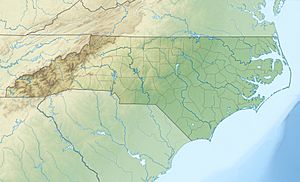Beaverdam Creek (Richardson Creek tributary) facts for kids
Quick facts for kids Beaverdam Creek |
|
|---|---|
|
Location of Beaverdam Creek mouth
|
|
| Other name(s) | Tributary to Richardson Creek |
| Country | United States |
| State | North Carolina |
| County | Union |
| Physical characteristics | |
| Main source | Little Richardson Creek divide pond about 0.25 miles northeast of Roughedge, North Carolina 675 ft (206 m) 34°54′16″N 080°37′14″W / 34.90444°N 80.62056°W |
| River mouth | Richardson Creek about 1.5 miles south of Monroe, North Carolina 505 ft (154 m) 34°55′16″N 080°37′29″W / 34.92111°N 80.62472°W |
| Length | 7.87 mi (12.67 km) |
| Basin features | |
| Progression | north then east |
| River system | Pee Dee |
| Basin size | 14.59 square miles (37.8 km2) |
| Tributaries |
|
| Bridges | S Rocky River Road, Parks McCorkle Road, S Rocky River Road, Doster Road, Fletcher Broome Road, Lancaster Highway, Griffith Road |
Beaverdam Creek is a small stream located in Union County, North Carolina. It flows for about 7.87 mi (12.67 km) (nearly 8 miles). This creek is a "tributary," which means it's a smaller stream that flows into a larger one. Beaverdam Creek joins Richardson Creek.
Contents
What is Beaverdam Creek?
Beaverdam Creek is an important part of the local water system. It is considered a "2nd order tributary." This means it's a stream formed when two smaller streams (called 1st order streams) come together. It then flows into an even larger stream.
Where Does it Start and End?
The journey of Beaverdam Creek begins in a pond. This pond is located about 0.25 miles northeast of a place called Roughedge, North Carolina. From there, the creek starts flowing towards the north.
After a while, it changes direction and turns to flow east. Its journey ends when it meets Richardson Creek. This meeting point is about 1.5 miles south of the town of Monroe, North Carolina.
The Land Around the Creek
The area that Beaverdam Creek drains is called its "watershed." Think of a watershed as a big bowl. All the rain that falls into this bowl eventually flows into the creek.
How Big is its Watershed?
Beaverdam Creek's watershed covers an area of about 14.59 square miles (37.8 km2) (nearly 15 square miles). This is the total land area that collects water for the creek.
Rainfall and Forests
The watershed receives a good amount of rain each year. On average, about 48.4 inches of precipitation falls here annually. This rain helps keep the creek flowing. About 38% of the land in the watershed is covered by forests. These forests are important. They help filter the water and provide homes for wildlife.
Why are Creeks Important?
Small creeks like Beaverdam Creek play a big role in nature. They are like the veins of the land. They carry water from higher elevations to larger rivers.
Supporting Nature
Creeks provide habitats for many plants and animals. Fish, insects, and other creatures depend on healthy creeks to live. The water from these creeks also helps plants grow along their banks.
Part of a Bigger System
Beaverdam Creek is part of a much larger river system. It flows into Richardson Creek, which then flows into the Pee Dee River. This shows how all waterways are connected. Even a small creek helps contribute to a major river.



